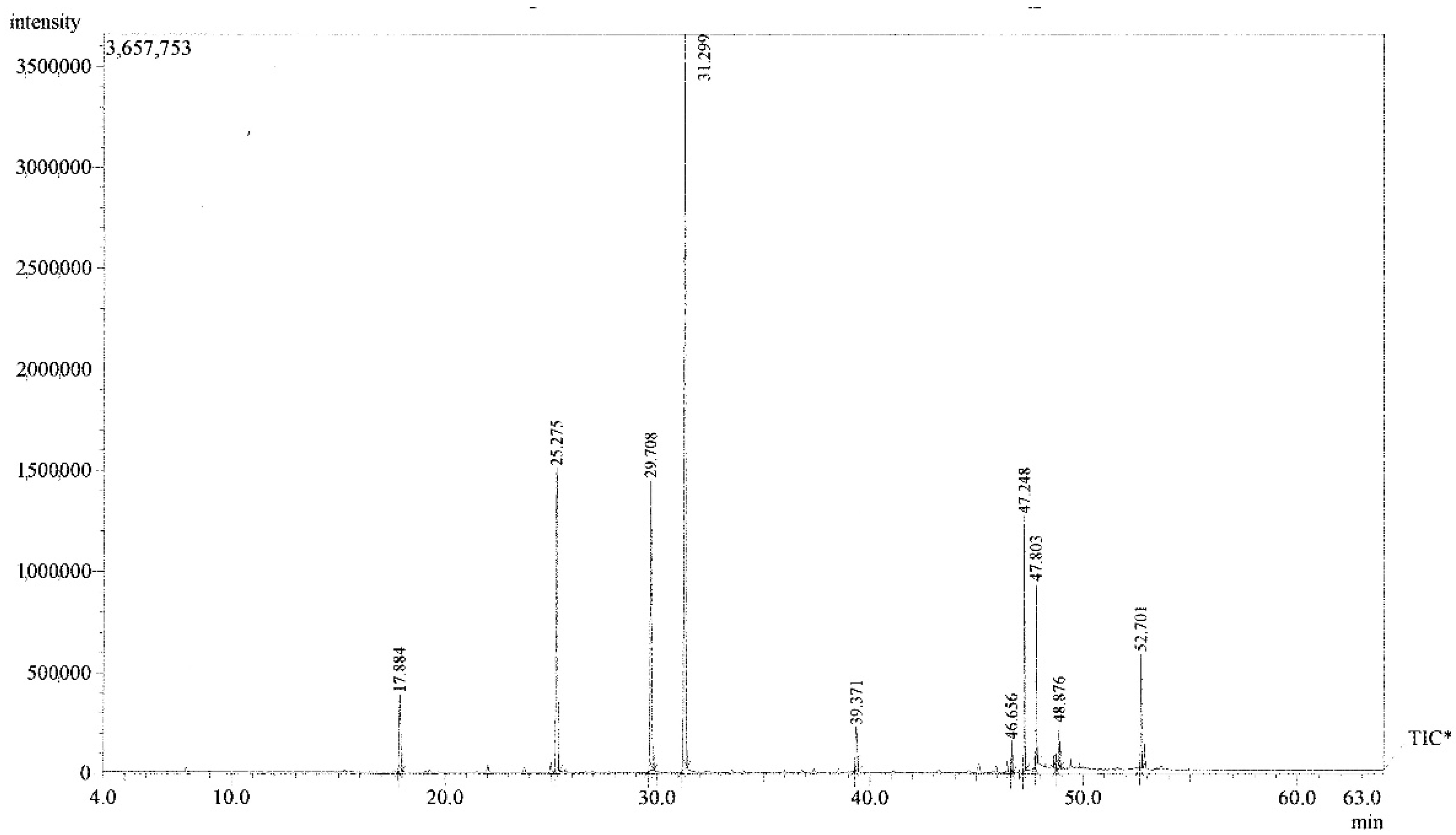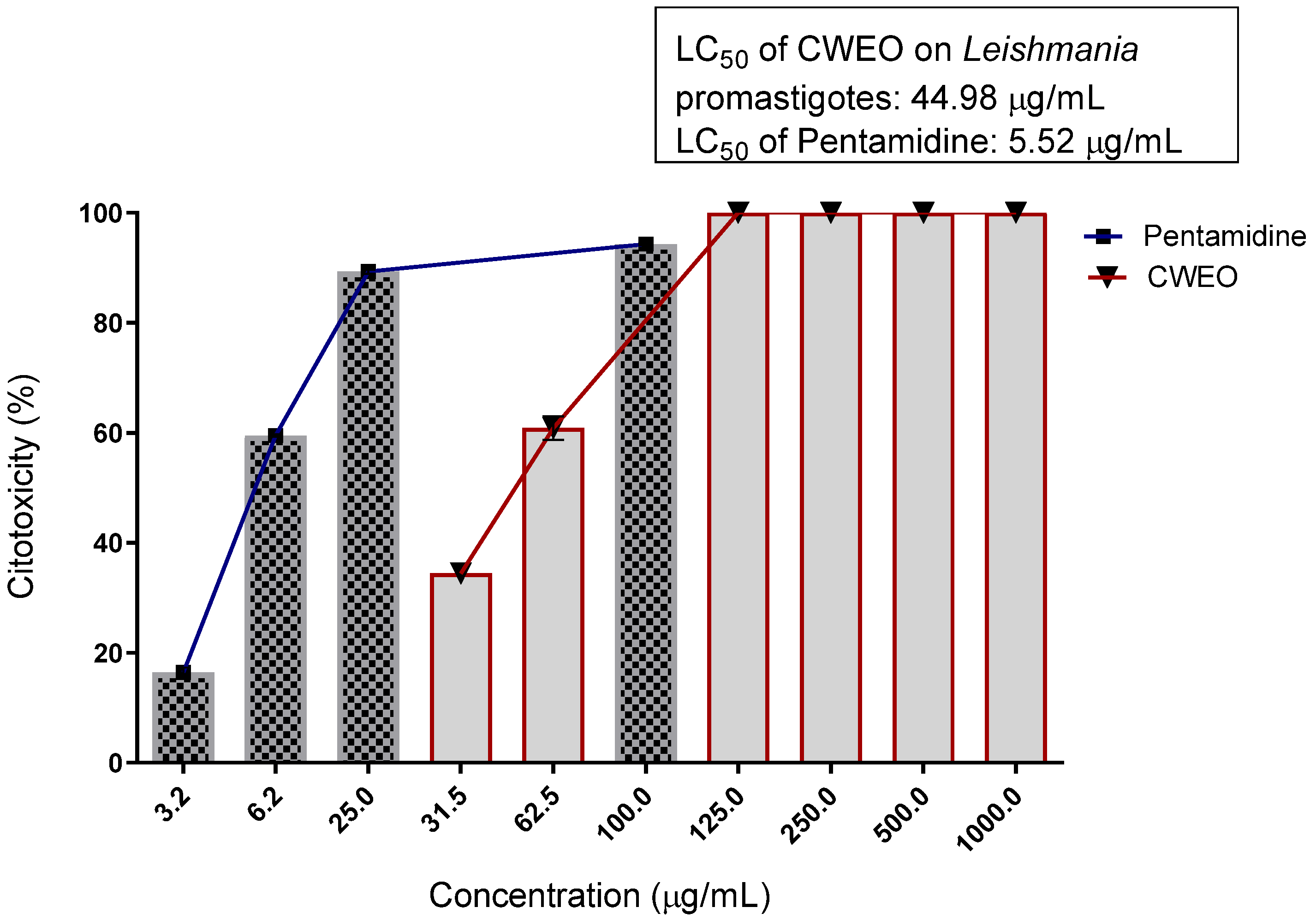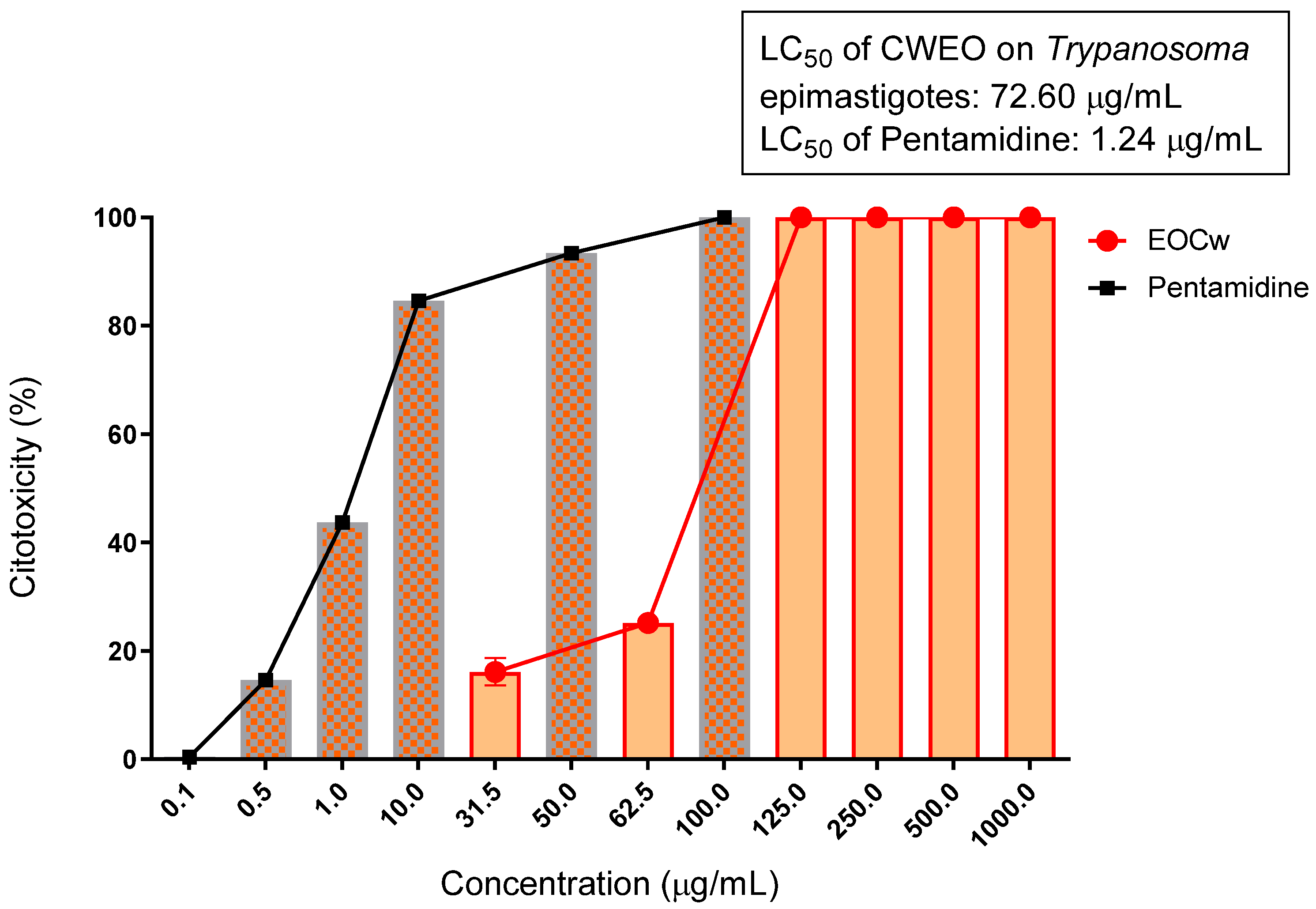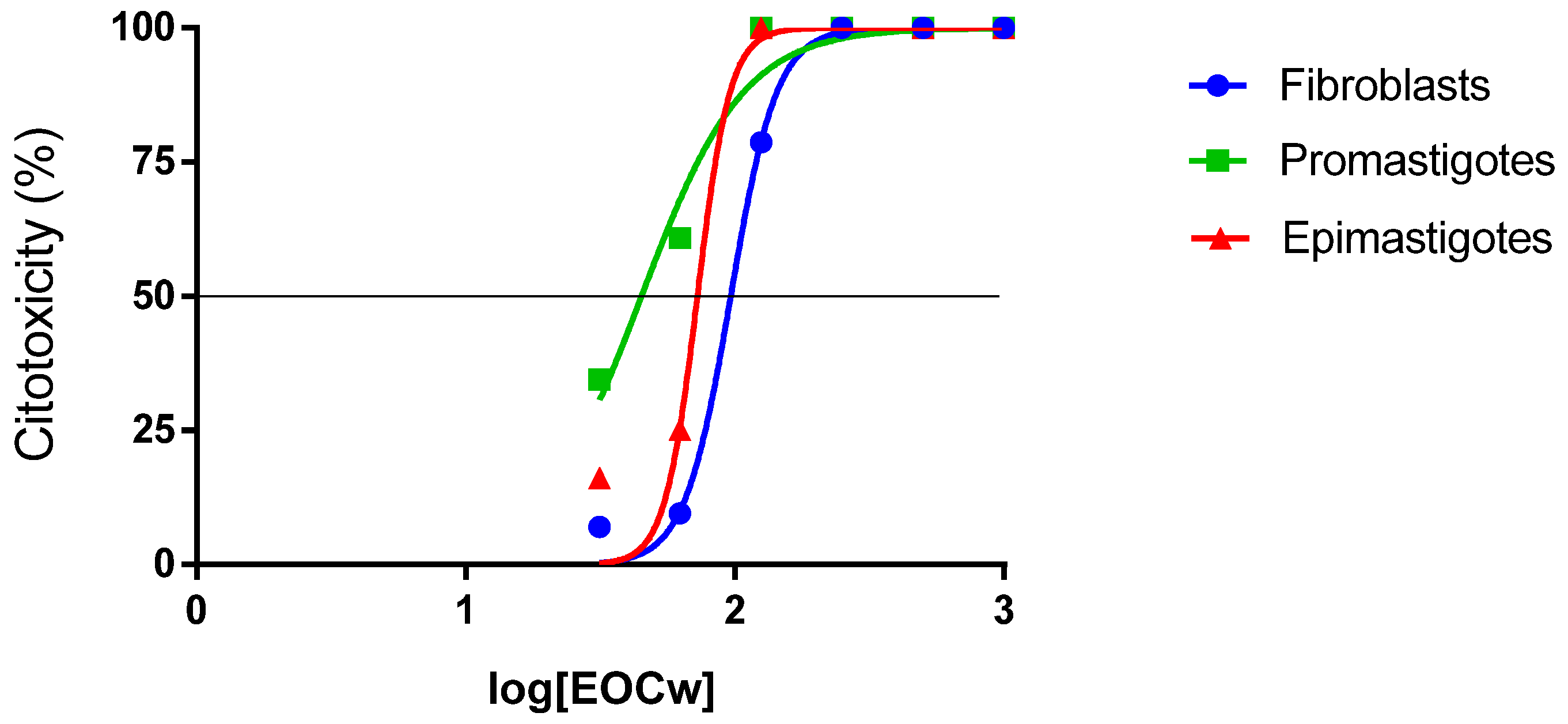Evaluation of the In Vitro Antiparasitic Effect of the Essential Oil of Cymbopogon winterianus and Its Chemical Composition Analysis
Abstract
1. Introduction
2. Results
3. Discussion
4. Materials and Methods
4.1. Plant Material, Selection, and Identification
4.2. Obtaining Essential Oil from C. winterianus
4.3. Essential Oil Chemical Identification
4.4. Antiparasitic Activity
4.4.1. Cell Lines Used
4.4.2. Reagents
4.4.3. In Vitro Epimastigote Sensitivity Assay
4.4.4. In Vitro Leishmanicidal Assay
4.5. Fibroblasts Cytotoxic Assays
4.6. Statistical Analysis
5. Conclusions
Author Contributions
Funding
Institutional Review Board Statement
Informed Consent Statement
Data Availability Statement
Acknowledgments
Conflicts of Interest
Sample Availability
References
- Hotez, P.J. A Plan to Defeat Neglected Tropical Diseases. Sci. Am. 2010, 302, 90–96. [Google Scholar] [CrossRef] [PubMed]
- Archibald, J.M.; Simpson, A.G.B.; Slamovits, C.H.; Margulis, L.; Melkonian, M.; Chapman, D.J.; Corliss, J.O. Handbook of the Protists; Archibald, J.M., Simpson, A.G.B., Slamovits, C.H., Margulis, L., Melkonian, M., Chapman, D.J., Corliss, J.O., Eds.; Springer International Publishing: Cham, Switzerland, 2017; ISBN 978-3-319-32669-6. [Google Scholar]
- WHO Leishmaniasis. Available online: https://www.who.int/news-room/fact-sheets/detail/leishmaniasis (accessed on 3 August 2021).
- Darcis, G.; Van der Auwera, G.; Giot, J.-B.; Hayette, M.-P.; Tassin, F.; Arrese Estrada, J.; Cnops, L.; Moutschen, M.; de Leval, L.; Leonard, P. Recurrence of visceral and muco-cutaneous leishmaniasis in a patient under immunosuppressive therapy. BMC Infect. Dis. 2017, 17, 478. [Google Scholar] [CrossRef] [PubMed]
- Kedzierski, L. Leishmaniasis. Hum. Vaccin. 2011, 7, 1204–1214. [Google Scholar] [CrossRef] [PubMed]
- Sundar, S.; Chakravarty, J. Leishmaniasis: An update of current pharmacotherapy. Expert Opin. Pharmacother. 2013, 14, 53–63. [Google Scholar] [CrossRef] [PubMed]
- Gibson, W. Kinetoplastea. In Handbook of the Protists; Springer International Publishing: Cham, Switzerland, 2016; pp. 1–50. [Google Scholar]
- Andrade, L.O.; Andrews, N.W. The Trypanosoma cruzi–host-cell interplay: Location, invasion, retention. Nat. Rev. Microbiol. 2005, 3, 819–823. [Google Scholar] [CrossRef]
- CDC Chagas Disease: Epidemiology and Risk Factors. Available online: https://www.cdc.gov/parasites/chagas/epi.html (accessed on 3 August 2021).
- Altcheh, J.; Castro, L.; Dib, J.C.; Grossmann, U.; Huang, E.; Moscatelli, G.; Pinto Rocha, J.J.; Ramírez, T.E. Prospective, historically controlled study to evaluate the efficacy and safety of a new paediatric formulation of nifurtimox in children aged 0 to 17 years with Chagas disease one year after treatment (CHICO). PLoS Negl. Trop. Dis. 2021, 15, e0008912. [Google Scholar] [CrossRef]
- Monzote, L.; Scherbakov, A.M.; Scull, R.; Satyal, P.; Cos, P.; Shchekotikhin, A.E.; Gille, L.; Setzer, W.N. Essential Oil from Melaleuca leucadendra: Antimicrobial, Antikinetoplastid, Antiproliferative and Cytotoxic Assessment. Molecules 2020, 25, 5514. [Google Scholar] [CrossRef]
- Rottini, M.M.; Amaral, A.C.F.; Ferreira, J.L.P.; Oliveira, E.S.C.; Silva, J.R.d.; Taniwaki, N.N.; Santos, A.R.d.; Almeida-Souza, F.; de Souza, C.d.F.; Calabrese, K.D. Endlicheria bracteolata (Meisn.) Essential Oil as a Weapon Against Leishmania amazonensis: In Vitro Assay. Molecules 2019, 24, 2525. [Google Scholar] [CrossRef]
- Lynch, M.C.; Cortelli, S.C.; McGuire, J.A.; Zhang, J.; Ricci-Nittel, D.; Mordas, C.J.; Aquino, D.R.; Cortelli, J.R. The effects of essential oil mouthrinses with or without alcohol on plaque and gingivitis: A randomized controlled clinical study. BMC Oral Health 2018, 18, 6. [Google Scholar] [CrossRef]
- Shasany, A.K.; Lal, R.K.; Patra, N.K.; Darokar, M.P.; Garg, A.; Kumar, S.; Khanuja, S.P.S. Phenotypic and RAPD diversity among Cymbopogon winterianus Jowitt accessions in relation to Cymbopogon nardus Rendle. Genet. Resour. Crop Evol. 2000, 47, 553–559. [Google Scholar] [CrossRef]
- Katiyar, R.; Gupta, S.; Yadav, K. Cymbopogon Winterianus: An Important Species for Essential Java Citronella Oil and Medicinal Value. In Proceedings of the National Conference on Forest Biodiversity: Earth’s Living Treasure, 22 May 2011; pp. 115–118. [Google Scholar]
- Rao, V.P.S.; Pandey, D. Extraction of Essential Oil and Its Applications. Ph.D. Thesis, National Institute of Technology, Rourkela, India, 2006. [Google Scholar]
- Zellner, B.D.A.; Dugo, P.; Dugo, G.; Mondello, L. Chapter 4: Natural Variability of Essential Oil Components. In Handbook of Essential Oils; CRC Press: Boca Raton, FA, USA, 2015; pp. 104–143. [Google Scholar]
- Jurevičiūtė, R.; Ložienė, K.; Bruno, M.; Maggio, A.; Rosselli, S. Composition of essential oil of lemon thyme (Thymus × citriodorus) at different hydrodistillation times. Nat. Prod. Res. 2019, 33, 80–88. [Google Scholar] [CrossRef] [PubMed]
- Hanif, M.A.; Nisar, S.; Khan, G.S.; Mushtaq, Z.; Zubair, M. Essential Oils. In Essential Oil Research; Springer International Publishing: Cham, Switzerland, 2019; pp. 3–17. [Google Scholar]
- Bergman, M.E.; Bhardwaj, M.; Phillips, M.A. Cytosolic geraniol and citronellol biosynthesis require a Nudix hydrolase in rose-scented geranium (Pelargonium graveolens). Plant J. 2021, 107, 493–510. [Google Scholar] [CrossRef] [PubMed]
- Christoforides, E.; Fourtaka, K.; Andreou, A.; Bethanis, K. X-ray crystallography and molecular dynamics studies of the inclusion complexes of geraniol in β-cyclodextrin, heptakis (2,6-di-O-methyl)-β-cyclodextrin and heptakis (2,3,6-tri-O-methyl)-β-cyclodextrin. J. Mol. Struct. 2020, 1202, 127350. [Google Scholar] [CrossRef]
- Gutensohn, M.; Orlova, I.; Nguyen, T.T.H.; Davidovich-Rikanati, R.; Ferruzzi, M.G.; Sitrit, Y.; Lewinsohn, E.; Pichersky, E.; Dudareva, N. Cytosolic monoterpene biosynthesis is supported by plastid-generated geranyl diphosphate substrate in transgenic tomato fruits. Plant J. 2013, 75, 351–363. [Google Scholar] [CrossRef]
- Ganjewala, D. Cymbopogon essential oils: Chemical compositions and bioactivities. Int. J. Essent. Oil Ther. 2009, 3, 56–65. [Google Scholar]
- Akhila, A. Essential Oil-Bearing Grasses The genus Cymbopogon; CRC Press: London, UK, 2010; ISBN 9780849378577. [Google Scholar]
- Khanuja, S.P.S.; Shasany, A.K.; Pawar, A.; Lal, R.K.; Darokar, M.P.; Naqvi, A.A.; Rajkumar, S.; Sundaresan, V.; Lal, N.; Kumar, S. Essential oil constituents and RAPD markers to establish species relationship in Cymbopogon Spreng. (Poaceae). Biochem. Syst. Ecol. 2005, 33, 171–186. [Google Scholar] [CrossRef]
- Beneti, S.C.; Rosset, E.; Corazza, M.L.; Frizzo, C.D.; Di Luccio, M.; Oliveira, J.V. Fractionation of citronella (Cymbopogon winterianus) essential oil and concentrated orange oil phase by batch vacuum distillation. J. Food Eng. 2011, 102, 348–354. [Google Scholar] [CrossRef]
- Simic, A.; Rančic, A.; Sokovic, M.D.; Ristic, M.; Grujic-Jovanovic, S.; Vukojevic, J.; Marin, P.D. Essential Oil Composition of Cymbopogon winterianus and Carum carvi. and Their Antimicrobial Activities. Pharm. Biol. 2008, 46, 437–441. [Google Scholar] [CrossRef]
- Kakaraparthi, P.S.; Srinivas, K.V.N.S.; Kumar, J.K.; Kumar, A.N.; Rajput, D.K.; Sarma, V.U.M. Variation in the essential oil content and composition of Citronella (Cymbopogon winterianus Jowitt.) in relation to time of harvest and weather conditions. Ind. Crops Prod. 2014, 61, 240–248. [Google Scholar] [CrossRef]
- Koba, K.; Sanda, K.; Guyon, C.; Raynaud, C.; Chaumont, J.-P.; Nicod, L. In vitro cytotoxic activity of Cymbopogon citratus L. and Cymbopogon nardus L. essential oils from Togo. Bangladesh J. Pharmacol. 2008, 4, 29–34. [Google Scholar] [CrossRef]
- Kpoviessi, S.; Bero, J.; Agbani, P.; Gbaguidi, F.; Kpadonou-Kpoviessi, B.; Sinsin, B.; Accrombessi, G.; Frédérich, M.; Moudachirou, M.; Quetin-Leclercq, J. Chemical composition, cytotoxicity and in vitro antitrypanosomal and antiplasmodial activity of the essential oils of four Cymbopogon species from Benin. J. Ethnopharmacol. 2014, 151, 652–659. [Google Scholar] [CrossRef] [PubMed]
- Tofiño-Rivera, A.; Ortega-Cuadros, M.; Galvis-Pareja, D.; Jiménez-Rios, H.; Merini, L.J.; Martínez-Pabón, M.C. Effect of Lippia alba and Cymbopogon citratus essential oils on biofilms of Streptococcus mutans and cytotoxicity in CHO cells. J. Ethnopharmacol. 2016, 194, 749–754. [Google Scholar] [CrossRef] [PubMed]
- Scherer, R.; Wagner, R.; Duarte, M.C.T.; Godoy, H.T. Composição e atividades antioxidante e antimicrobiana dos óleos essenciais de cravo-da-índia, citronela e palmarosa. Rev. Bras. Plantas Med. 2009, 11, 442–449. [Google Scholar] [CrossRef]
- Leite, B.L.S.; Bonfim, R.R.; Antoniolli, A.R.; Thomazzi, S.M.; Araújo, A.A.S.; Blank, A.F.; Estevam, C.S.; Cambui, E.V.F.; Bonjardim, L.R.; Albuquerque Júnior, R.L.C.; et al. Assessment of antinociceptive, anti-inflammatory and antioxidant properties of Cymbopogon winterianus leaf essential oil. Pharm. Biol. 2010, 48, 1164–1169. [Google Scholar] [CrossRef] [PubMed]
- Silva, M.R.; Ximenes, R.M.; da Costa, J.G.M.; Leal, L.K.A.M.; de Lopes, A.A.; de Barros Viana, G.S. Comparative anticonvulsant activities of the essential oils (EOs) from Cymbopogon winterianus Jowitt and Cymbopogon citratus (DC) Stapf. in mice. Naunyn Schmiedebergs Arch. Pharmacol. 2010, 381, 415–426. [Google Scholar] [CrossRef]
- Hasim, H.; Nasution, S.P.; Kurniawati, S.O.; Rachmawati, I. Cytotoxic Activity of Citral from Cymbopogon nardus as Anticancer of MCM-B2 Cell. Curr. Biochem. 2020, 7, 29–36. [Google Scholar] [CrossRef]
- Sinha, S.; Jothiramajayam, M.; Ghosh, M.; Mukherjee, A. Evaluation of toxicity of essential oils palmarosa, citronella, lemongrass and vetiver in human lymphocytes. Food Chem. Toxicol. 2014, 68, 71–77. [Google Scholar] [CrossRef]
- Queiroz, T.B.; Santos, G.F.; Ventura, S.C.; Hiruma-Lima, C.A.; Gaivão, I.O.M.; Maistro, E.L. Cytotoxic and genotoxic potential of geraniol in peripheral blood mononuclear cells and human hepatoma cell line (HepG2). Genet. Mol. Res. 2017, 16, 1–12. [Google Scholar] [CrossRef]
- Gateva, S.; Jovtchev, G.; Stankov, A.; Georgieva, A.; Dobreva, A.; Mileva, M. The potential of geraniol to reduce cytotoxic and genotoxic effects of MNNG in plant and human lymphocyte test-systems. S. Afr. J. Bot. 2019, 123, 170–179. [Google Scholar] [CrossRef]
- Machado, M.; Pires, P.; Dinis, A.M.; Santos-Rosa, M.; Alves, V.; Salgueiro, L.; Cavaleiro, C.; Sousa, M.C. Monoterpenic aldehydes as potential anti-Leishmania agents: Activity of Cymbopogon citratus and citral on L. infantum, L. tropica and L. major. Exp. Parasitol. 2012, 130, 223–231. [Google Scholar] [CrossRef]
- Santin, M.R.; dos Santos, A.O.; Nakamura, C.V.; Dias Filho, B.P.; Ferreira, I.C.P.; Ueda-Nakamura, T. In vitro activity of the essential oil of Cymbopogon citratus and its major component (citral) on Leishmania amazonensis. Parasitol. Res. 2009, 105, 1489–1496. [Google Scholar] [CrossRef] [PubMed]
- Ceole, L.F.; Cardoso, M.D.G.; Soares, M.J. Nerolidol, the main constituent of Piper aduncum essential oil, has anti- Leishmania braziliensis activity. Parasitology 2017, 144, 1179–1190. [Google Scholar] [CrossRef] [PubMed]
- Carneiro, J.N.P.; Albuquerque, R.S.; Leite, N.F.; Machado, A.J.T.; de Brito, D.I.V.; Rolón, M.; Vega, C.; Coronel, C.; Coutinho, H.D.M.; Morais-Braga, M.F.B. Avaliação Da Atividade Tripanocida, Leishmanicida e Citotóxica do Geraniol e Citronelal. Cad. Cult. Ciênc. 2015, 13, 29–36. [Google Scholar] [CrossRef]
- Brito, A.M.G. Avaliação da Atividade Antileishmanial dos óleos Essenciais das Plantas Cymbopogon citratus (DC.) Stapf., Eucalyptus citriodora Hook., Mentha arvensis L., e Mentha piperita L. Ph.D. Thesis, Tiradente University, Aracaju, Brazil, 2019. [Google Scholar]
- Essid, R.; Rahali, F.Z.; Msaada, K.; Sghair, I.; Hammami, M.; Bouratbine, A.; Aoun, K.; Limam, F. Antileishmanial and cytotoxic potential of essential oils from medicinal plants in Northern Tunisia. Ind. Crops Prod. 2015, 77, 795–802. [Google Scholar] [CrossRef]
- Ogungbe, I.; Setzer, W. In-silico Leishmania Target Selectivity of Antiparasitic Terpenoids. Molecules 2013, 18, 7761–7847. [Google Scholar] [CrossRef]
- Vidhya, V.M.; Dubey, V.K.; Ponnuraj, K. Identification of two natural compound inhibitors of Leishmania donovani Spermidine Synthase (SpdS) through molecular docking and dynamic studies. J. Biomol. Struct. Dyn. 2018, 36, 2678–2693. [Google Scholar] [CrossRef]
- Youssefi, M.R.; Moghaddas, E.; Tabari, M.A.; Moghadamnia, A.A.; Hosseini, S.M.; Farash, B.R.H.; Ebrahimi, M.A.; Mousavi, N.N.; Fata, A.; Maggi, F.; et al. In Vitro and In Vivo Effectiveness of Carvacrol, Thymol and Linalool against Leishmania infantum. Molecules 2019, 24, 2072. [Google Scholar] [CrossRef]
- Ueda-Nakamura, T.; Mendonça-Filho, R.R.; Morgado-Díaz, J.A.; Korehisa Maza, P.; Prado Dias Filho, B.; Aparício Garcia Cortez, D.; Alviano, D.S.; do Rosa, M.S.S.; Lopes, A.H.C.S.; Alviano, C.S.; et al. Antileishmanial activity of Eugenol-rich essential oil from Ocimum gratissimum. Parasitol. Int. 2006, 55, 99–105. [Google Scholar] [CrossRef]
- Muhd Haffiz, J.; Norhayati, I.; Getha, K.; Nor Azah, M.A.; Mohd Ilham, A.; Lili Sahira, H.; Roshan Jahn, M.S.; Muhd Syamil, A. Chemical composition and in vitro antitrypanosomal activity of fractions of essential oil from Cymbopogon nardus L. Trop. Biomed. 2013, 30, 9–14. [Google Scholar]
- Rojas, J.; Ronceros, S.; Palacios, O.; Sevilla, C. Efecto anti-Trypanosoma cruzi del aceite esencial de Cymbopogon citratus (DC) Stapf (Hierba luisa) en ratones Balb/c. An. Fac. Med. 2012, 73, 7. [Google Scholar] [CrossRef][Green Version]
- Costa, S.; Cavadas, C.; Cavaleiro, C.; Salgueiro, L.; do Céu Sousa, M. In vitro susceptibility of Trypanosoma brucei brucei to selected essential oils and their major components. Exp. Parasitol. 2018, 190, 34–40. [Google Scholar] [CrossRef] [PubMed]
- Cardoso, J.; Soares, M.J. In vitro effects of citral on Trypanosoma cruzi metacyclogenesis. Mem. Inst. Oswaldo Cruz 2010, 105, 1026–1032. [Google Scholar] [CrossRef] [PubMed]
- Azeredo, C.M.O.; Soares, M.J. Combination of the essential oil constituents citral, eugenol and thymol enhance their inhibitory effect on Crithidia fasciculata and Trypanosoma cruzi growth. Rev. Bras. Farmacogn. 2013, 23, 762–768. [Google Scholar] [CrossRef][Green Version]
- Kouassi, E.; Coulibaly, I.; Rodica, P.; Pintea, A.; Ouattara, S.; Odagiu, A. HPLC Phenolic Compounds Analysis and Antifungal Activity of extract’s from Cymbopogon citratus (DC) Stapf against Fusarium graminearum and Fusarium oxysporum sp. tulipae. J. Sci. Res. Rep. 2017, 14, 1–11. [Google Scholar] [CrossRef]
- Molina-Garza, Z.J.; Bazaldúa-Rodríguez, A.F.; Quintanilla-Licea, R.; Galaviz-Silva, L. Anti-Trypanosoma cruzi activity of 10 medicinal plants used in northeast Mexico. Acta Trop. 2014, 136, 14–18. [Google Scholar] [CrossRef] [PubMed]
- Santoro, G.F.; Cardoso, M.G.; Guimarães, L.G.L.; Freire, J.M.; Soares, M.J. Anti-proliferative effect of the essential oil of Cymbopogon citratus (DC) Stapf (lemongrass) on intracellular amastigotes, bloodstream trypomastigotes and culture epimastigotes of Trypanosoma cruzi (Protozoa: Kinetoplastida). Parasitology 2007, 134, 1649–1656. [Google Scholar] [CrossRef] [PubMed]
- Moreno, É.M.; Leal, S.M.; Stashenko, E.E.; García, L.T. Induction of programmed cell death in Trypanosoma cruzi by Lippia alba essential oils and their major and synergistic terpenes (citral, limonene and caryophyllene oxide). BMC Complement. Altern. Med. 2018, 18, 225. [Google Scholar] [CrossRef]
- dos Anjos, D.O.; Sobral Alves, E.S.; Gonçalves, V.T.; Fontes, S.S.; Nogueira, M.L.; Suarez-Fontes, A.M.; Neves da Costa, J.B.; Rios-Santos, F.; Vannier-Santos, M.A. Effects of a novel β–lapachone derivative on Trypanosoma cruzi: Parasite death involving apoptosis, autophagy and necrosis. Int. J. Parasitol. Drugs Drug Resist. 2016, 6, 207–219. [Google Scholar] [CrossRef]
- Shimadzu Corporation. Gas Chromatography-Mass Spectrometry (GC-MS). Available online: https://www.shimadzu.eu.com/sites/shimadzu.seg/files/SEG/GCMSBASIC.pdf (accessed on 15 April 2022).
- Shimadzu Corporation. Relative Retention. Available online: https://www.ssi.shimadzu.com/products/gas-chromatography-mass-spectrometry/relative_retention.html (accessed on 15 April 2022).
- Le-Senne, A.; Muelas-Serrano, S.; Fernández-Portillo, C.; Escario, J.A.; Gómez-Barrio, A. Biological characterization of a beta-galactosidase expressing clone of Trypanosoma cruzi CL strain. Mem. Inst. Oswaldo Cruz 2002, 97, 1101–1105. [Google Scholar] [CrossRef]
- Roldos, V.; Nakayama, H.; Rolón, M.; Montero-Torres, A.; Trucco, F.; Torres, S.; Vega, C.; Marrero-Ponce, Y.; Heguaburu, V.; Yaluff, G. Activity of a hydroxybibenzyl bryophyte constituent against Leishmania spp. and Trypanosoma cruzi: In silico, in vitro and in vivo activity studies. Eur. J. Med. Chem. 2008, 43, 1797–1807. [Google Scholar] [CrossRef]
- Vega, C.; Rolón, M.; Martínez-Fernández, A.R.; Escario, J.A.; Gómez-Barrio, A. A new pharmacological screening assay with Trypanosoma cruzi epimastigotes expressing beta-galactosidase. Parasitol. Res. 2005, 95, 296–298. [Google Scholar] [CrossRef] [PubMed]
- Mikus, J.; Steverding, D. A simple colorimetric method to screen drug cytotoxicity against Leishmania using the dye Alamar Blue®. Parasitol. Int. 2000, 48, 265–269. [Google Scholar] [CrossRef]





| Components | RT (min) a | (%) |
|---|---|---|
| Limonene | 17.88 | 4.24 |
| Citronellal | 25.27 | 17.31 |
| Citronellol | 29.70 | 16.91 |
| Geraniol | 31.29 | 42.13 |
| β-elemene | 39.37 | 2.69 |
| δ-Cadinene | 46.65 | 1.05 |
| Elemol | 47.24 | 6.71 |
| Germacrene | 47.80 | 4.44 |
| Guaiol | 48.87 | 1.14 |
| Nerolidol | 52.70 | 3.38 |
| Total | 100.00 |
| Natural Product | Conc. µg/mL | %C | ±%DS |
|---|---|---|---|
| C. winterianus | 1000 | 0 | – |
| 500 | 0 | – | |
| 250 | 2.15 | 0.49 | |
| 125 | 35.79 | 0.80 | |
| 62.5 | 89.96 | 0.70 | |
| 31.5 | 90.96 | 0.77 |
| Natural Product | Conc. µg/mL C. winterianus | %S | ±%DS | Conc. µg/mL Pentamidine | %S | ±%DS |
|---|---|---|---|---|---|---|
| C. winterianus | 1000 | 0 | - | |||
| 500 | 0 | - | ||||
| 250 | 0 | - | ||||
| 125 | 0 | - | ||||
| 100 | 5.7 | 0.2 | ||||
| 62.5 | 39.13 | 2.11 | ||||
| 31.5 | 65.56 | 1.02 | ||||
| 25 | 10.7 | 0.4 | ||||
| 6.2 | 40.5 | 0.2 | ||||
| 3.2 | 83.6 | 0.9 |
| Natural Product | Conc. µg/mL C. winterianus | %S | ± %DS | Conc. g/mL Pentamidine | %S | ±%DS |
|---|---|---|---|---|---|---|
| C. winterianus | 1000 | 0 | – | |||
| 500 | 0 | – | ||||
| 250 | 0 | – | ||||
| 125 | 0 | – | ||||
| 100 | 0 | 0.7 | ||||
| 62.5 | 74.89 | 1.70 | ||||
| 50 | 6.6 | 0.5 | ||||
| 31.5 | 83.88 | 2.52 | ||||
| 10 | 15.4 | 0.6 | ||||
| 1.0 | 56.3 | 0.5 | ||||
| 0.5 | 85.4 | 0.6 | ||||
| 0.1 | 99.6 | 0.3 |
Publisher’s Note: MDPI stays neutral with regard to jurisdictional claims in published maps and institutional affiliations. |
© 2022 by the authors. Licensee MDPI, Basel, Switzerland. This article is an open access article distributed under the terms and conditions of the Creative Commons Attribution (CC BY) license (https://creativecommons.org/licenses/by/4.0/).
Share and Cite
Pereira, P.S.; Oliveira, C.V.B.; Maia, A.J.; Vega-Gomez, M.C.; Rolón, M.; Coronel, C.; Duarte, A.E.; Coutinho, H.D.M.; Siyadatpanah, A.; Norouzi, R.; et al. Evaluation of the In Vitro Antiparasitic Effect of the Essential Oil of Cymbopogon winterianus and Its Chemical Composition Analysis. Molecules 2022, 27, 2753. https://doi.org/10.3390/molecules27092753
Pereira PS, Oliveira CVB, Maia AJ, Vega-Gomez MC, Rolón M, Coronel C, Duarte AE, Coutinho HDM, Siyadatpanah A, Norouzi R, et al. Evaluation of the In Vitro Antiparasitic Effect of the Essential Oil of Cymbopogon winterianus and Its Chemical Composition Analysis. Molecules. 2022; 27(9):2753. https://doi.org/10.3390/molecules27092753
Chicago/Turabian StylePereira, Pedro Silvino, Carlos Vinicius Barros Oliveira, Ana Josicleide Maia, Maria Celeste Vega-Gomez, Miriam Rolón, Cathia Coronel, Antônia Eliene Duarte, Henrique Douglas Melo Coutinho, Abolghasem Siyadatpanah, Roghayeh Norouzi, and et al. 2022. "Evaluation of the In Vitro Antiparasitic Effect of the Essential Oil of Cymbopogon winterianus and Its Chemical Composition Analysis" Molecules 27, no. 9: 2753. https://doi.org/10.3390/molecules27092753
APA StylePereira, P. S., Oliveira, C. V. B., Maia, A. J., Vega-Gomez, M. C., Rolón, M., Coronel, C., Duarte, A. E., Coutinho, H. D. M., Siyadatpanah, A., Norouzi, R., Sadati, S. J. A., Wilairatana, P., & Silva, T. G. (2022). Evaluation of the In Vitro Antiparasitic Effect of the Essential Oil of Cymbopogon winterianus and Its Chemical Composition Analysis. Molecules, 27(9), 2753. https://doi.org/10.3390/molecules27092753







